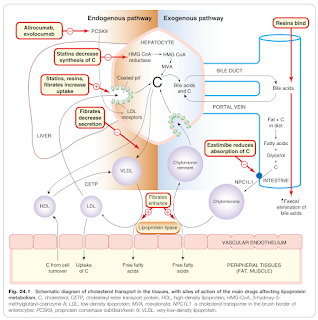Lipid-Lowering Drugs
Introduction
Lipids, including cholesterol and triglycerides, are transported in the plasma as lipoproteins, of which there are 4 classes.
- Chylomicrons transport triglycerides and cholesterol from the gastrointestinal tract to the tissues, where triglyceride is split by lipoprotein lipase, releasing free fatty acids and glycerol which are taken up in muscle and adipose tissue. Chylomicron remnants are taken up in the liver, where cholesterol is stored, secreted in bile, oxidised to bile acids or converted into VLDLs.
- Very-low-density lipoproteins (VLDLs) transport cholesterol and newly synthesised triglycerides to the tissues, where triglycerides are removed as before, leaving LDLs.
- Intermediate-density and low-density lipoprotein (LDL) particles with a large component of cholesterol; some cholesterol is taken up by the tissue and some by the liver, by endocytosis via specific LDL receptors.
- High-density lipoprotein (HDL) particles absorb cholesterol derived from cell breakdown in tissues (including arteries) and transfer it to VLDL and LDL particles via cholesterol ester transport protein (CETP).
In addition to dietary measures and correction of other modifiable cardiovascular risk factors, the main agents used clinically to decrease plasma lipoprotein concentrations are
- Statins
- Fibrates
- Inhibitors of cholesterol absorption
- Nicotinic acid or its derivatives
- PCSK9 inhibitors
- Small interfering RNA (siRNA) PCSK-9 inhibitors
Statins
Fibrates
Fibrates are thought to act by binding to peroxisome proliferator-activated receptor α (PPARα) on hepatocytes. This then leads to changes in the expression of genes involved in lipoprotein metabolism.
- Consequently, fibrates reduce triglyceride and, to a lesser extent, LDL-C levels, while increasing HDL-C.
- Fibrates take 2-5 days to have measurable effect on VLDL-C, with their optimum effect present after 4 weeks.
- Members include bezafibrate, ciprofibrate, fenofibrate and gemfibrozil.
Fibrates are mainly used in those whose serum-triglyceride concentration is greater than 10 mmol/litre or in those who cannot tolerate a statin (specialist use).
- Fenofibrate has a uricosuric effect, which can reduce uric acid concentrations by about 25%.
Fibrates are known to significantly increase the effect of anticoagulants, while concurrent use with a statin is associated with an increased risk of myositis and, rarely, rhabdomyolysis.
- The risk with gemfibrozil is 15 times higher when compared to fenofibrate because it interferes with statin glucuronidation.
- The combination of statins and gemfibrozil is discouraged. The myopathy risk is minimal with pravastatin combination.
- Fibrates should preferably be taken in the morning and statins in the evening to minimize peak dose concentrations and decrease the risk of myopathy.
Inhibitors of Cholesterol Absorption
In the past, bile acid-binding resins (e.g. cholestyramine, colestipol) were the only agents available to reduce cholesterol absorption and hence, lower plasma cholesterol.
Ezetimibe is a more potent drug than resins (a daily dose of 10 mg) and can be used as supplementary treatment to statins in patients with severe dyslipidaemia.
- It is not recommended in patients with moderate to severe hepatic impairment.
PCSK9 Inhibitors
PCSK9 is synthesised in inactive form by many tissues, including brain and liver.
- When activated, it binds to LDL receptors and promotes their lysosomal degradation following LDL uptake into hepatocyte cytoplasm. This prevents the recycling of LDL receptors to surface membrane, which diminishes their ability to sequester LDL.
Two monoclonal antibody PCSK9 inhibitors, alirocumab and evolocumab, have recently been licensed.
- Both drugs are administered by subcutaneous injection and require storage in a refrigerator.
More data are needed to assess the long-term safety of PCSK9 inhibitors, including neurocognitive and immunogenic effects as well as long-term consequences of very low LDL.
Small Interfering RNA (siRNA) PCSK-9 Inhibitors
Inclisiran is a long-acting, synthetic siRNA molecule that binds to an RNA-induced silencing complex (RISC), thereby inhibiting the translation of PCSK9 messenger RNA (mRNA) causing a marked reduction in LDL-C levels.
- Inclisiran is administered subcutaneously.
- Inclisiran should not be used in combination with PCSK-9 inhibitors since there is no evidence of additive LDL lowering.


thanks very much
ReplyDelete